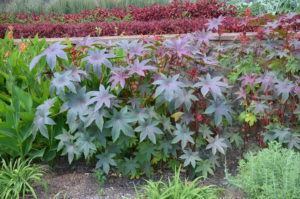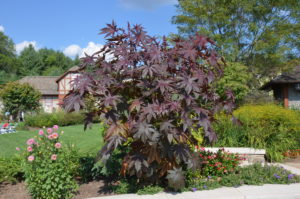 Over the years castor bean (Ricinus communis) plants have been a common sight in public gardens. These tall ornamental annuals are cherished for both their colorful flowers and seed capsules, and bold foliage. The species, a botanical member of the spurge family (Euphorbiaceae), is indigenous to the southeastern Mediterranean region, Eastern Africa, and India. Unlike many spurges, the sap is watery and not milky.
Over the years castor bean (Ricinus communis) plants have been a common sight in public gardens. These tall ornamental annuals are cherished for both their colorful flowers and seed capsules, and bold foliage. The species, a botanical member of the spurge family (Euphorbiaceae), is indigenous to the southeastern Mediterranean region, Eastern Africa, and India. Unlike many spurges, the sap is watery and not milky.
Castor bean is known by a number of colloquial names including mole killer plant and castor oil plant. Each fruit is a spiny capsule containing large, bean-like seeds, with a brownish mottling shells. Despite its name, castor bean is not a true “bean”. Plant stems and spiny seed pods vary in color and are showier than the actual blooms. The male flowers are yellowish-green with creamy white stamens. The female flowers hide within the spiny seed pods, have red stigmas, and are produced in less numbers than the male.
Modern day landscape varieties are selected for leaf and flower color as well as oil production. Growth rate is very rapid and can easily grow 10 feet and more in a single growing season. Its enormous, glossy palmate star-like leaves measure anywhere from 6 to 30 inches across, and leaf lobes, numbering 5 to 11, are deeply cut. Each leaf is attached by a long slender petiole to the main stalk. With some varieties the leaves start off reddish purple, bronze or green, gradually developing darker tones as they mature.
Planting into your landscape, sow the seeds or transplant starts in full day sun and in deep humus-rich soil. In northern areas, where the growing season may be short, start plants from seeds indoors. Shelter plants from strong winds that can damage the large, glossy leaves. Water and fertilize generously for super- sized plants.
In the 16th century, castor oil was utilized as an alternative to lamp oil. In the U.S., castor bean plants were grown for its oil, used in making soaps, linoleum, nylon, paints, et al. In the first half of the 20th century it was also used as a laxative and in skin and hair cosmetic products. Plant roots repel gophers and moles.
Warning: the colorful castor bean “beans” are highly ornamental and highly poisonous. if ingested. If you wish to save the seed from one year to the next, wear rubber gloves to carefully cut apart the seed stalk. Allow the seed pods to dry in a cool dry room; crack open and remove the seeds carefully. Place the seeds in a paper envelope and store inside your refrigerator. Be certain to label “highly poisonous”.
Recommended Varieties:
‘New Zealand Purple’
‘Carmencita Bright Red’, ‘Pink’, ‘Rose’
‘Gibsonii’
‘Red Spire’


 Posted in
Posted in 
